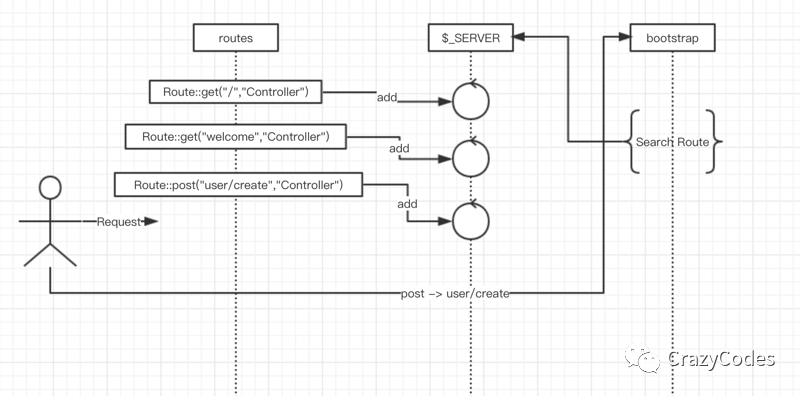来!狂撸一款PHP现代化框架 (路由的设计)

前言
上一篇的标题改了一下,以一、二、三为章节对读者来说是种困扰,现在的标题是依照项目进度来编写的。上篇文章地址为 https://segmentfault.com/a/11...
这一系列文章并不准备写太多章节,大概规划的只有4~5章左右,具体实现代码还请移步Github
https://github.com/CrazyCodes...
本章详细讲解一下Route(路由的实现),Come on Up Image

上图大概说明了实现路由要经过两个步骤
将所有路由信息存储到超全局变量中
用户请求时从全局变量中查找路由映射的服务脚本并实例化
OK,大概流程就是酱紫,下面开始“撸”
目录
路由的代码暂分为以下几个文件(这并不是确定的,详细可查看Github)
| 文件名 | 注释 |
|---|---|
| Route | 转发文件:为实现 Route::get 效果 |
| RouteCollection | 路由信息处理存储 |
| RouteInterface | 无需解释 |
| RouteModel | 路由模型,将每个路由信息以结构体方式存储到$_SERVER |
| Router | 路由的核心类 |
莫急,我们一个一个文件来看。先从RouteInterface开始
RouteInterface
参照RESTful规定设定接口方法分别为 GET、POST、PATCH、PUT、DELETE、OPTIONS,当然Laravel也是规范了以上标准请求。
GitHub : https://github.com/CrazyCodes...
interface RouteInterface
{
/**
* @param $uri
* @param null $action
*
* @return mixed
*/
public function get($uri, $action = null);
/**
* @param $uri
* @param null $action
*
* @return mixed
*/
public function post($uri, $action = null);
/**
* @param $uri
* @param null $action
*
* @return mixed
*/
public function patch($uri, $action = null);
/**
* @param $uri
* @param null $action
*
* @return mixed
*/
public function put($uri, $action = null);
/**
* @param $uri
* @param null $action
*
* @return mixed
*/
public function delete($uri, $action = null);
/**
* @param $uri
* @param null $action
*
* @return mixed
*/
public function options($uri, $action = null);
}Router
先写一个栗子
public function get($uri, $action = null)
{
return $this->addRoute("GET", $uri, $action);
}用户调用下方代码会指向上述方法,方法既调用addRoute方法将路由信息存储到$_SERVER中
Route::get('/','Controller')以下为addRoute部分的代码
public function addRoute($methods, $uri, $action)
{
// 这里判断请求方式是否合规,既是否存在 GET、POST、PATCH、PUT、DELETE、OPTIONS其中之一
if ($this->verify($methods) == false) {
return false;
}
// 之后我们去往RouteCollection路由信息的处理类中
return $this->routes->add($uri, $this->createRoute($methods, $action));
}RouteCollection
最终达到 add 方法,将路由信息存储到$_SERVER中
public function add($uri, RouteModel $model)
{
if (empty($_SERVER["routes"][$uri])) {
$_SERVER["routes"][$uri] = $model;
}
}第二个参数RouteModel开始我们说过这是路由模型,将每个路由以结构体的方式存储到变量中,存储后的结果
'routes' =>
array(6) {
'test/get' =>
class Zero\Routing\RouteModel#13 (2) {
public $method =>
string(3) "GET"
public $action =>
string(19) "testController@test"
}
'test/post' =>
class Zero\Routing\RouteModel#14 (2) {
public $method =>
string(4) "POST"
public $action =>
string(19) "testController@test"
}
'test/put' =>
class Zero\Routing\RouteModel#15 (2) {
public $method =>
string(3) "PUT"
public $action =>
string(18) "testController@put"
}
'test/del' =>
class Zero\Routing\RouteModel#16 (2) {
public $method =>
string(6) "DELETE"
public $action =>
string(18) "testController@del"
}
'test/patch' =>
class Zero\Routing\RouteModel#17 (2) {
public $method =>
string(5) "PATCH"
public $action =>
string(20) "testController@patch"
}
'test/opt' =>
class Zero\Routing\RouteModel#18 (2) {
public $method =>
string(7) "OPTIONS"
public $action =>
string(18) "testController@opt"
}
}Route
最后通过__callStatic将代码重定向到核心类中
public static function __callStatic($name, $arguments)
{
$router = new Router;
return $router->{$name}($arguments[0], $arguments[1]);
}上述套路部分是Laravel的设计思想,通过这款简单的框架可对Laravel核心设计有丁点的理解。
测试
测试上次做的有点糙,从本章到系列结束,我们都以PHPunit来测试。
/**
* @content tests all methods storage -> $_SERVER["routes"]
*/
public function testAllMethodsStorage()
{
$this->routes->get($methodGet = "test/get", "testController@test");
$this->assertArrayHasKey($methodGet, $_SERVER[$this->methodsDataKey]);
$this->routes->post($methodPost = "test/post", "testController@test");
$this->assertArrayHasKey($methodPost, $_SERVER[$this->methodsDataKey]);
$this->routes->put($methodPut = "test/put", "testController@put");
$this->assertArrayHasKey($methodPut, $_SERVER[$this->methodsDataKey]);
$this->routes->delete($methodDel = "test/del", "testController@del");
$this->assertArrayHasKey($methodDel, $_SERVER[$this->methodsDataKey]);
$this->routes->patch($methodPatch = "test/patch", "testController@patch");
$this->assertArrayHasKey($methodPatch, $_SERVER[$this->methodsDataKey]);
$this->routes->options($methodOpt = "test/opt", "testController@opt");
$this->assertArrayHasKey($methodOpt, $_SERVER[$this->methodsDataKey]);
}上述贴出部分代码,以过程化的方法去测试。查看存储是否符合预期。
/**
* @content RouteModel Success
*/
public function testCreateRoute()
{
$response = $this->routes->createRoute("GET", "TestController@Get");
$this->assertInstanceOf(RouteModel::class, $response);
}包括测试对路由创建后是否为RouteModel的实现。具体可查看Github
https://github.com/CrazyCodes...
致谢
上述已完成了路由的基本设计,下一章将讲解从启动到请求路由映射到服务脚本的过程。
希望本章可以帮到你,谢谢。
